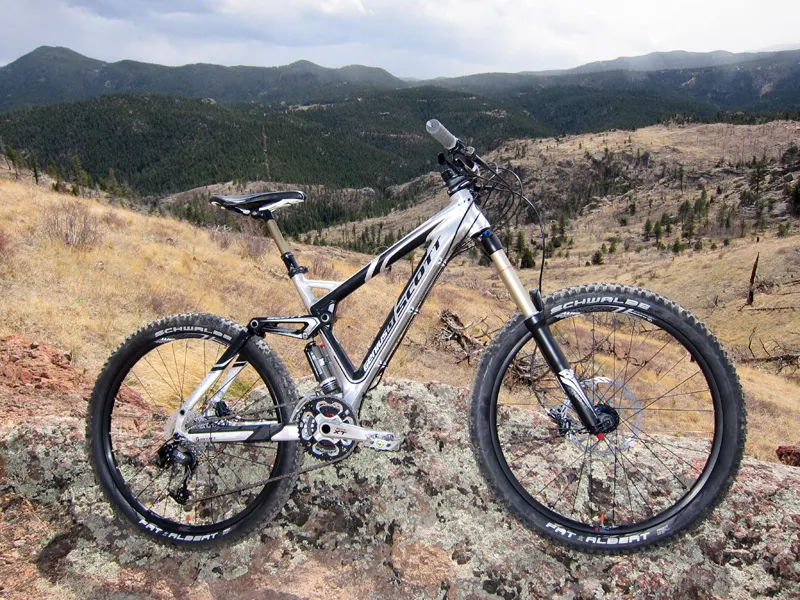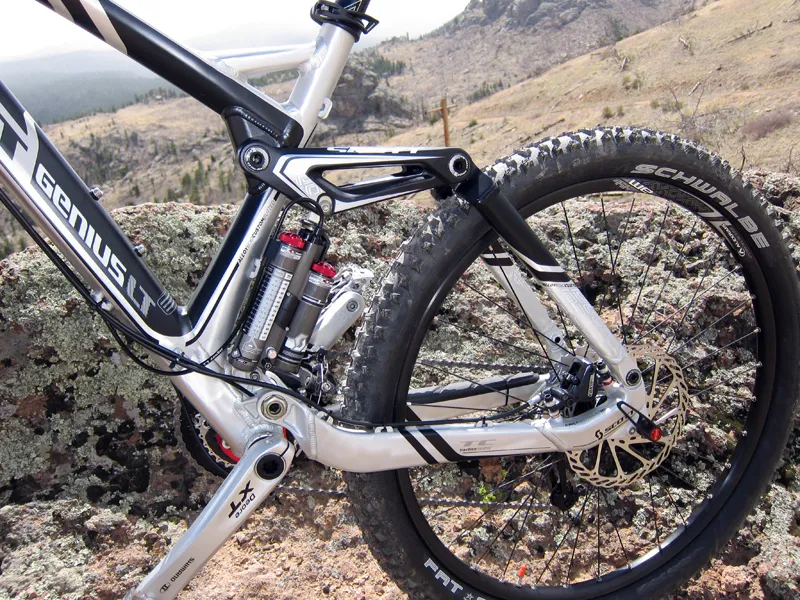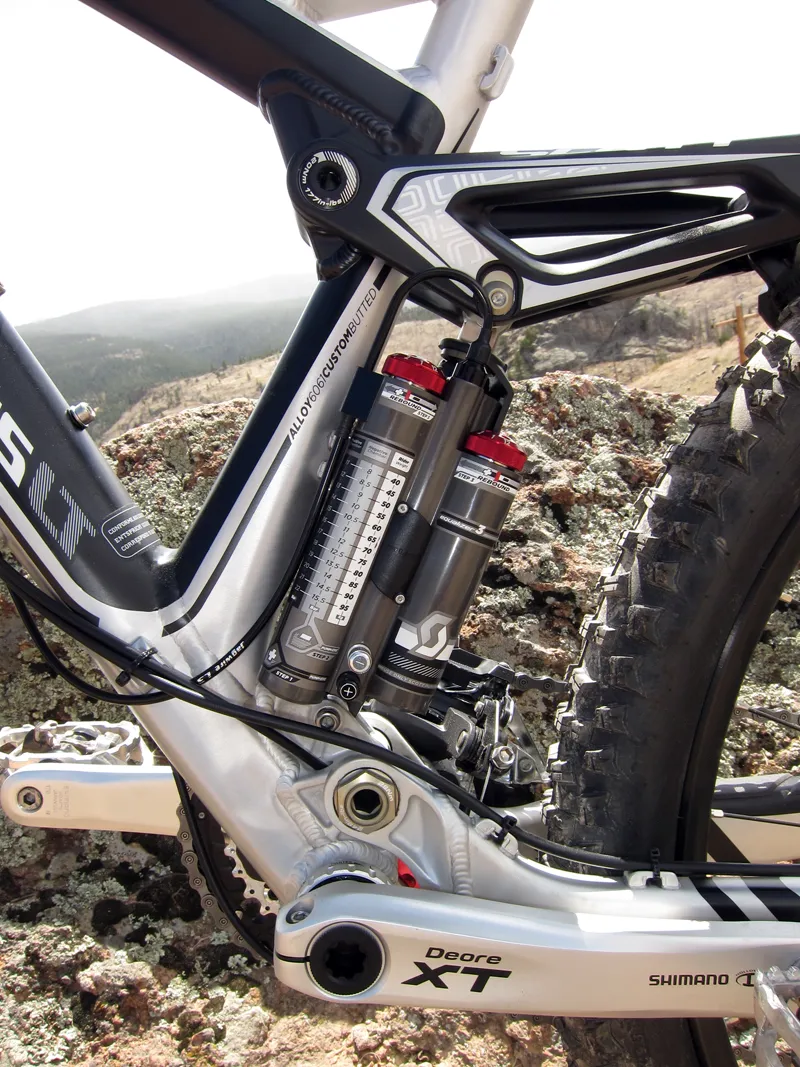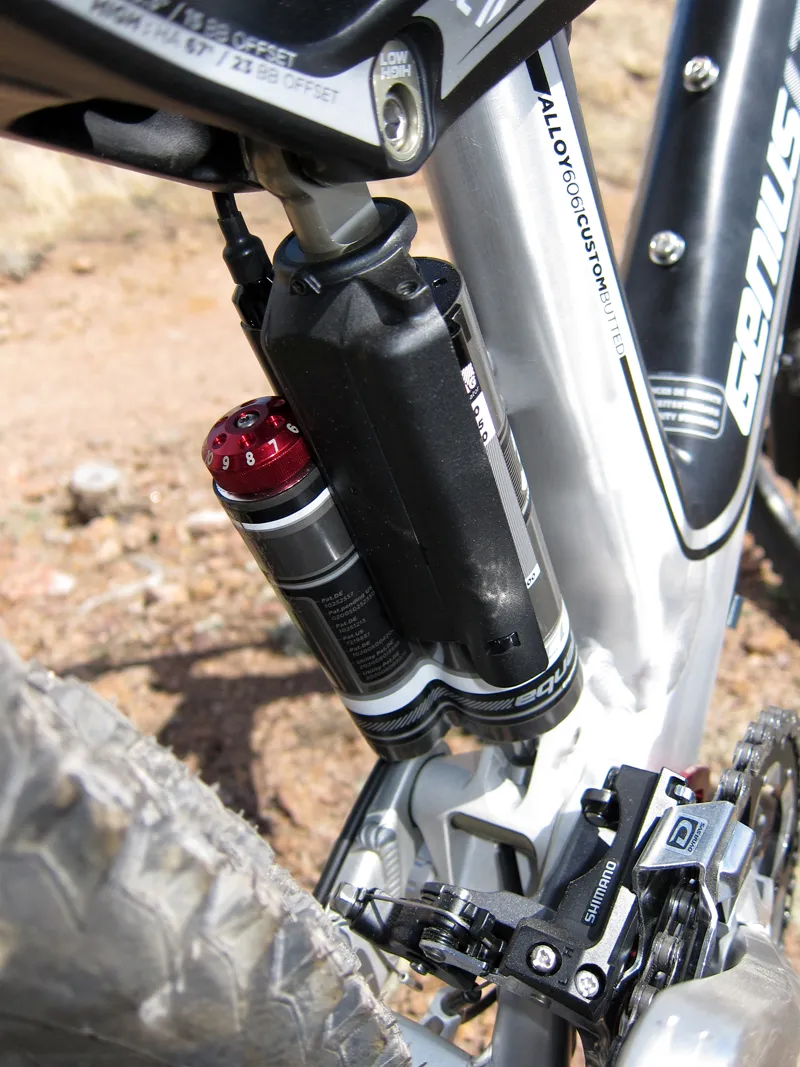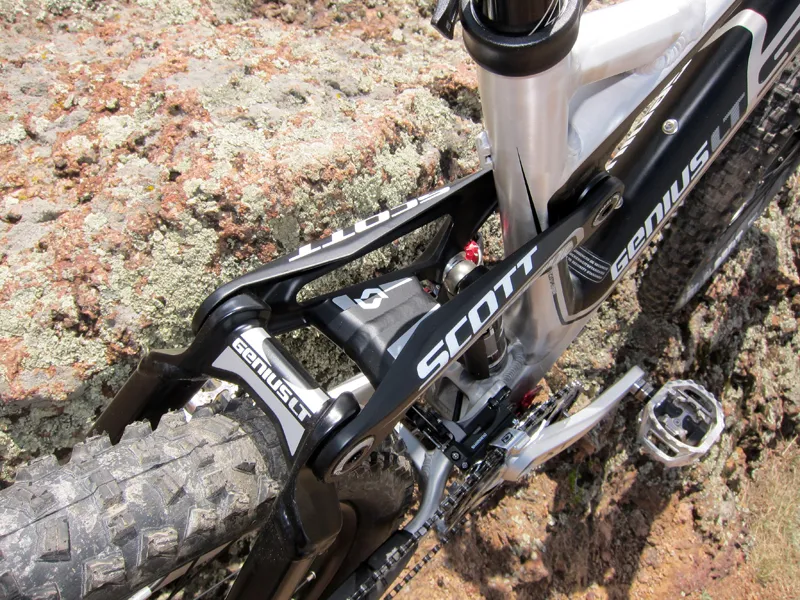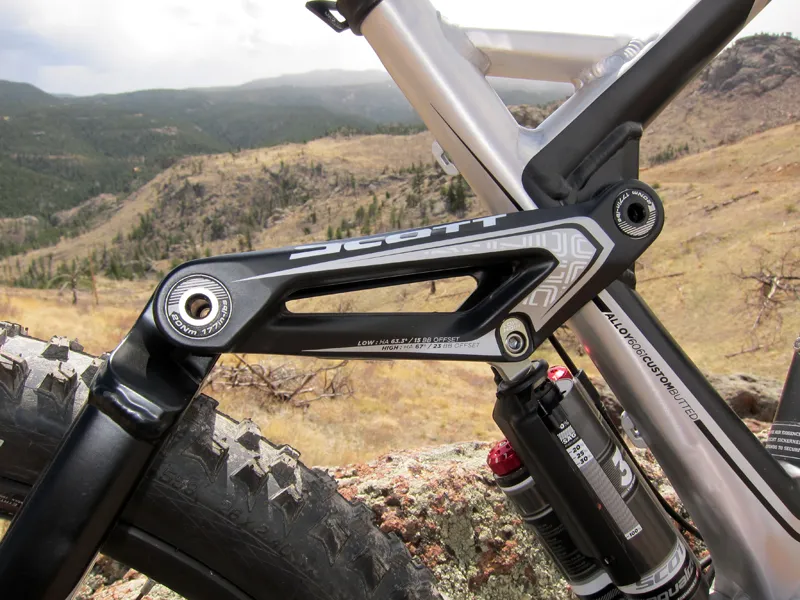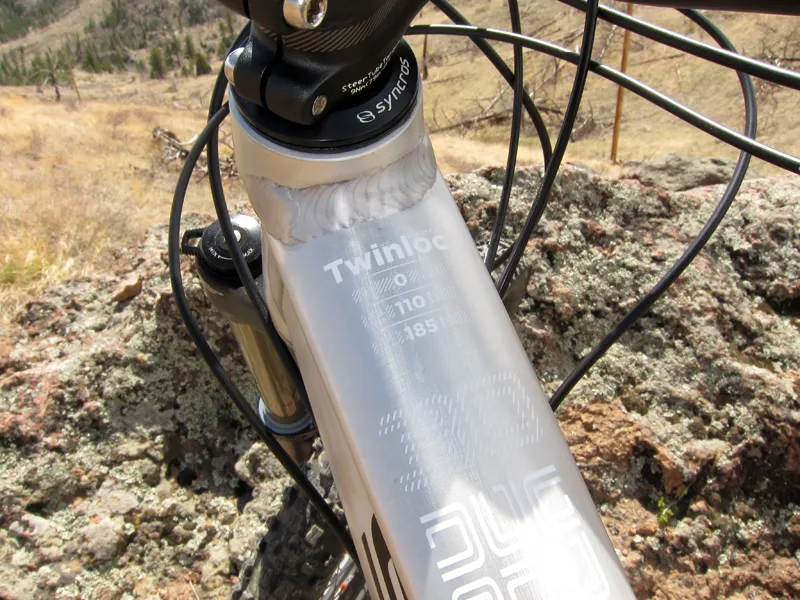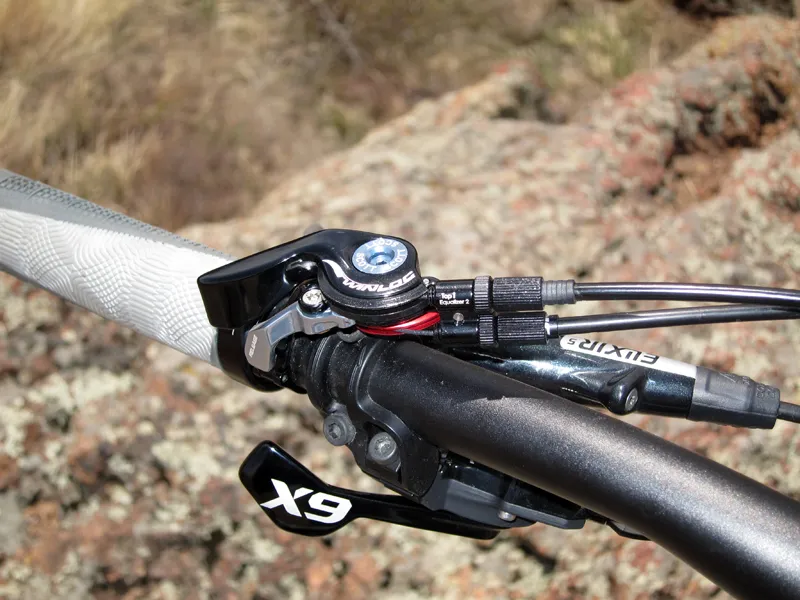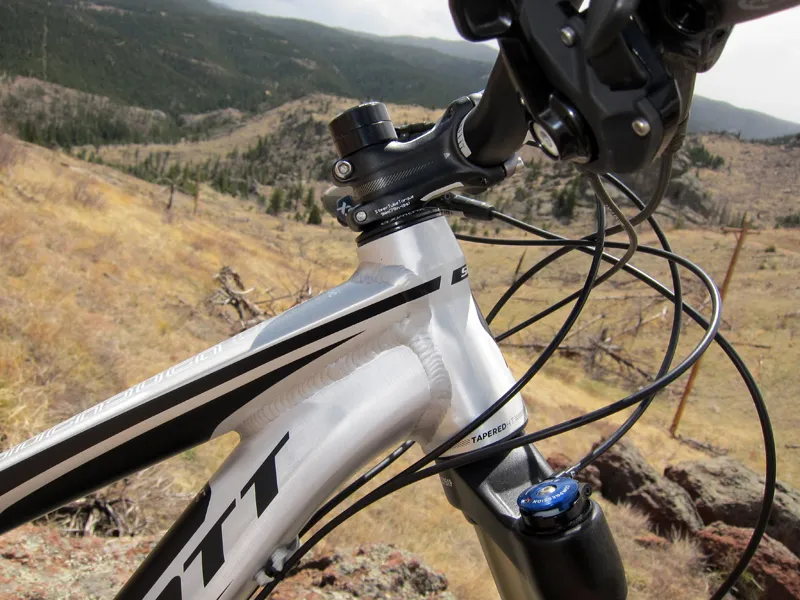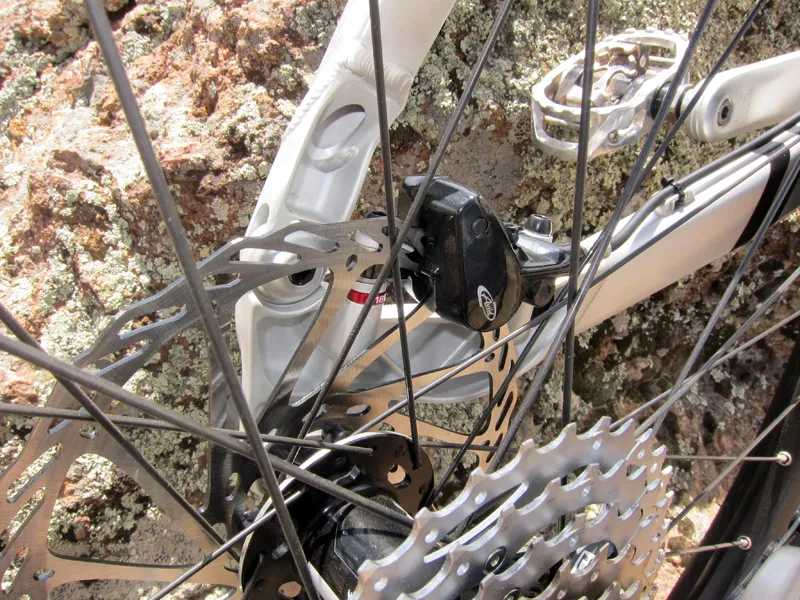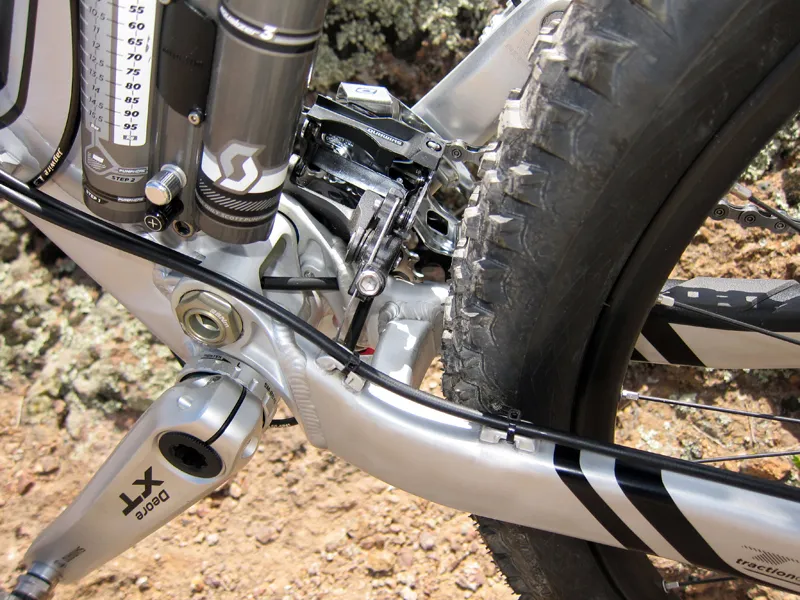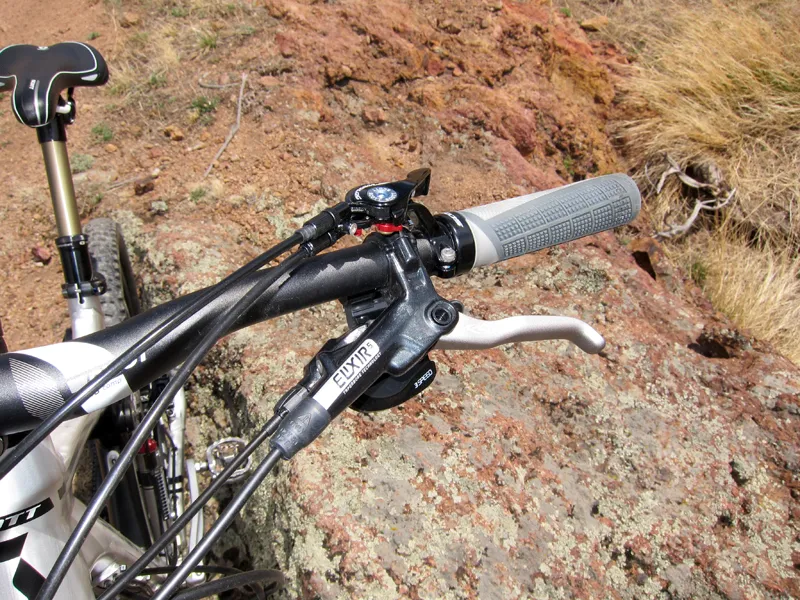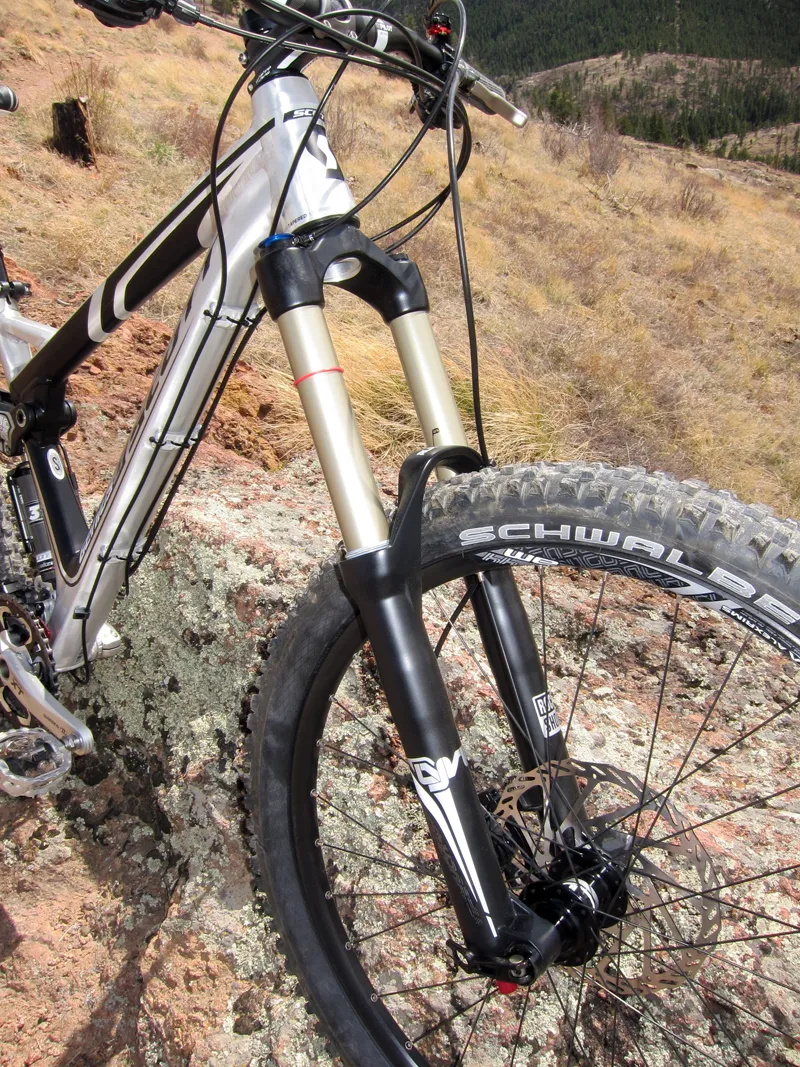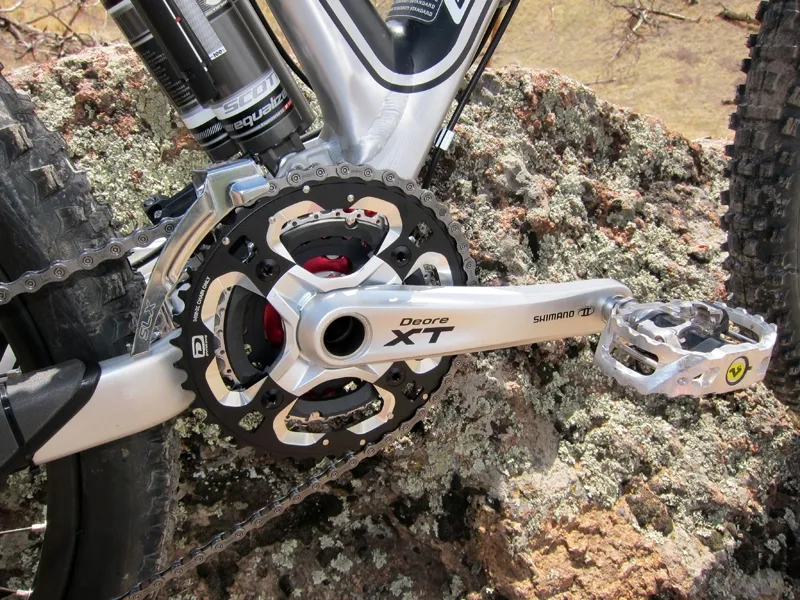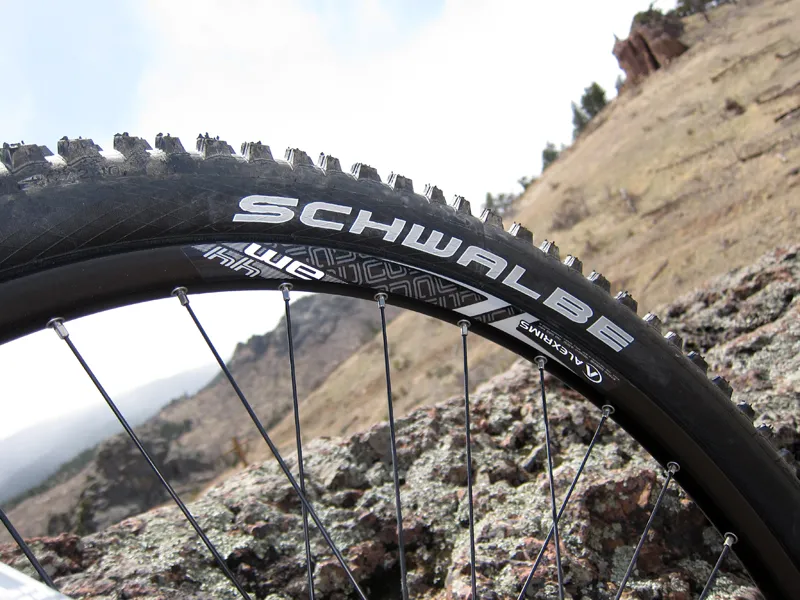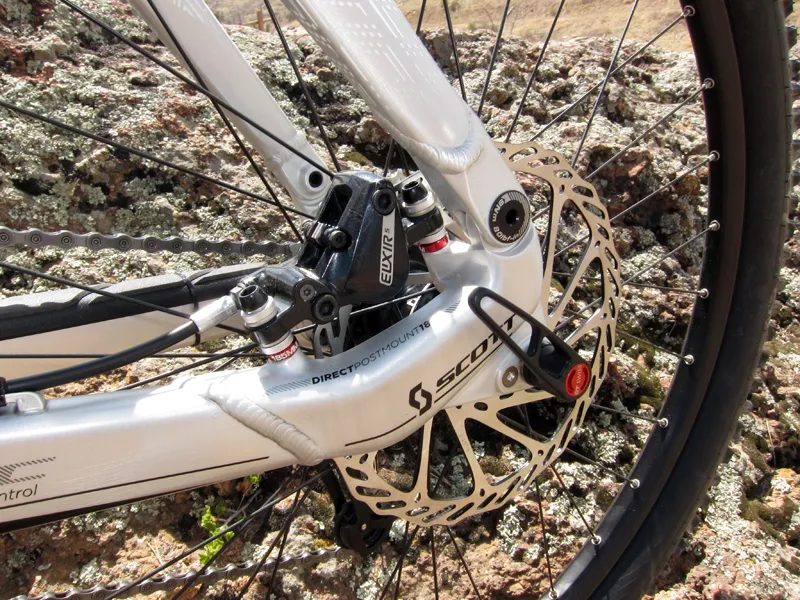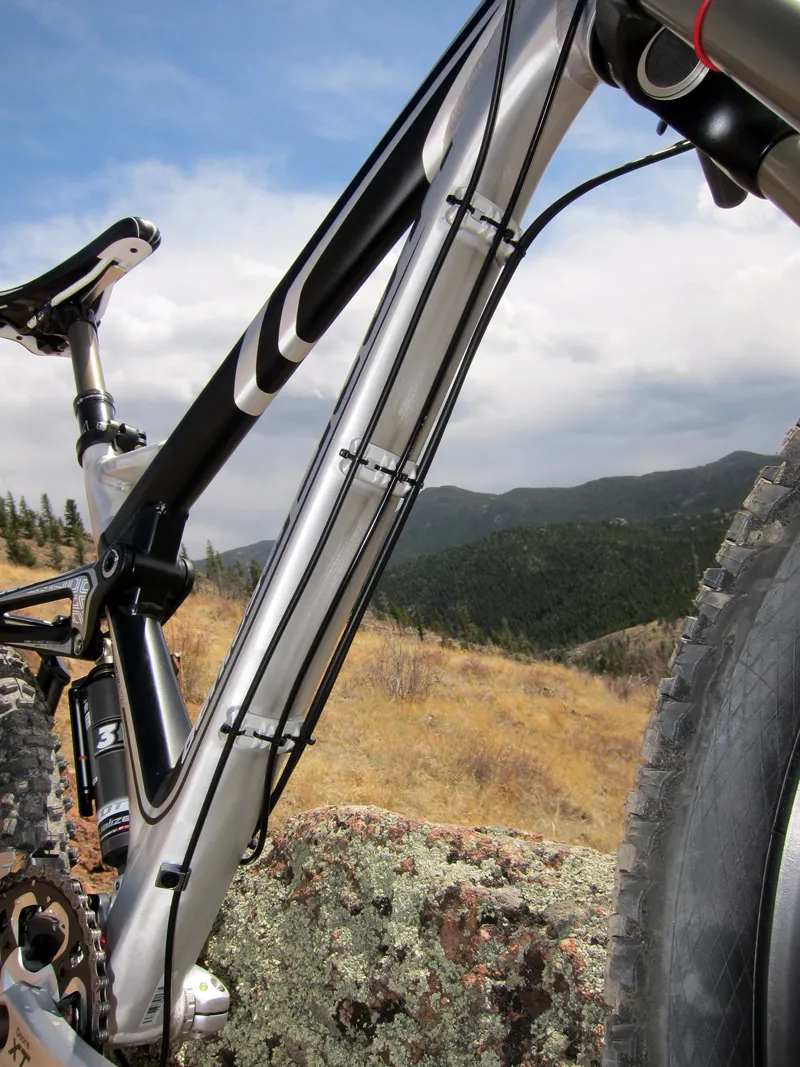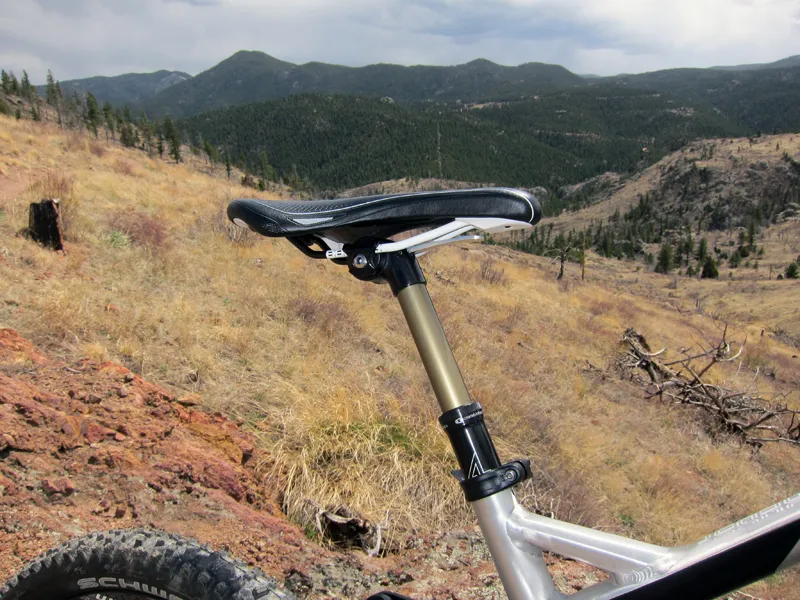Scott's new Genius LT is the latest longer-travel all-mountain machine to promise cross-country-like climbing abilities coupled to near-freeride-like descending chops. To a large extent, it delivers on those claims, with 185mm of available rear wheel travel but also clever 110mm and full-lockout modes that turn it into a surprisingly reasonable climber.
The selectively efficient rear end still can't mask the bike's relative heft, though, so while the Genius LT is a beast going downhill, you'd best make sure you pick a pretty big mountain to extract the full fun potential.
Ride & handling: Two bikes in one at the flick of a switch
Rather than attempt to design a long-travel full-suspension system that pedals with inherent efficiency or lean on often-compromising platform shock valving, Scott instead rely on their trademark TwinLoc bar-mounted lever system to meld two distinct personalities into the Genius LT's faux-bar single-pivot layout.
The Genius LT 30 is a ripper in full-travel mode, with a bottomless, suitably progressive and well-controlled stroke that gobbles up big hits and levels medium-sized ones. Stomping flat landings borders on mundane and provided the rebound damping is set properly, the Genius LT 30 doesn't even make you pay a hefty price if you case a tabletop. We regularly used all of the available travel on bigger features and bottom-out isn't unduly harsh.
The overall feel on less extreme terrain is more taut than pillowy, however, with only so-so small bump sensitivity even with the Equalizer 3 shock's negative air chamber inflated above Scott's prescribed recommendations. High-frequency trail chatter is dulled but not eliminated and the suspension isn't as isolating as some might expect of a bike with this much travel.
Likewise for the custom 180mm-travel, air-sprung RockShox Lyrik RLR fork, which happily plowed through bigger boulders and drops but was somewhat lacking in suppleness on smaller stuff.
Full-travel mode brings with it a long, slack and stable geometry that's perfectly suited to the high speeds Scott intend the Genius LT to see. A flippable 'chip' in the upper shock mount allows users to tune the handling a bit but in either case you'll be flying low and fast with head tube angles that vary between 66.3 and 67 degrees and corresponding bottom bracket heights that hover at a knuckle-dragging 358 or 367mm (14.1 or 14.4in) off the ground.
Even without dropping the seatpost, it's easy and natural to sink your weight deep into corners and rail out of berms or comfortably two-wheel-drift through loose turns without feeling like you could high-side at any moment.
Normally bikes with this much travel would be prone to rampant pedal strikes but that's just one of the issues addressed when flipping the TwinLoc switch into 'traction' mode. In addition to cutting the travel and stiffening the shock for more efficient pedaling, 'traction' mode also raises the sag point and bottom bracket height, effectively steepening the head tube angle.
This gives slightly more nimble handling in tight singletrack and a more comfortable position for climbing. If that's not enough, a crown-mounted switch on the fork drops the front end by 40mm (though doing so brings the pedal strike issue back into play – we didn't use it much).
Like on Scott's latest Spark, the shorter travel mode also brings with it a notably stiffer shock stroke, though in this case there's still enough movement to provide some extra grip on tricky ascents relative to a fully locked out rear end. We still found it a little too firm for general use on fast sections of trail that require a lot of pedaling, however.
Push the TwinLoc lever all the way forward and you do get just that: a full lockout, and one that's conveniently effective at both ends. Save for stretches of pavement on the way to a trailhead or relatively smooth fire roads, however, we didn't find much use for this setting once on the trail but it's nice to have all the same.
Scott hang all of this big-hit hardware on a suitably stiff and burly alloy chassis that looks and feels the part. There's only modest perceptible wiggle from either end when barreling through rock gardens or leaning especially hard through a tricky corner, and no tendency to shoot you offline when landing jumps or drops despite the main pivot and rear shock mounts sitting noticeably off-center.
This all being said, the Genius LT 30 is still most at home on a big mountain, and on a big ride – preferably one that starts with a long, steady climb and ends with a healthy, technical descent. At 14.48kg (31.92lb) complete (15.07kg/33.22lb with Shimano PD-M545 pedals), the LT will steadily make its way up the mountain but will take its time doing so as gravity exacts a pretty firm hold. Add in the relaxed geometry and the Genius LT 30 isn't the easiest to muscle up super-punchy, technical climbs that require a lot of body English and quick bursts of power, either.
Frame: Big hydroformed tubes, through-axles, and large-diameter pivots all around
Scott make no apologies for the chunky construction of the Genius LT alloy frame, which weighs a substantial 3.37kg (7.43lb, size small, with rear shock, rear derailleur hanger, seatpost collar and TwinLoc remote). It's designed for abuse and rather than put something together that looks good on paper weight-wise, Scott look to have erred on the side of durability, which many Genius LT owners will likely appreciate long-term given how the bike is apt to be used.
The hydroformed and butted 6061 aluminum tubes are on the big side throughout, and the tapered head tube allows for a notably large-diameter down tube. The seat tube is offset forward to leave room for the multi-chamber pull shock (which sits in an inverted orientation to reduce unsprung weight), the rear dropouts are deeply sculpted and webbed, and while the upper link isn't a one-piece forging, its center section boasts a chunky welded section that effectively makes it so.
Adding to the strong and stiff personality are through-axles at both ends: 142x12mm out back and a 110x20mm up front. As is currently the fashion, all of the control cables use full-length housing and are routed on the underside of the down tube with zip-ties. Skeptics will worry about rock strikes but we didn't encounter any issues during testing. Extra stops are provided for a remotely operated dropper post, too.
Equipment: Capable mix but screams out for a chain retention device and remote dropper
Scott outfit the Genius LT 30 with an eclectic mix of components: SRAM X9 shifters, rear derailleur and rear hub; a Shimano Deore XT crankset; an SLX front derailleur and cassette; Avid Elixir 5 hydraulic brakes with 203mm front and 185mm rear rotors; custom wheels built with wide Alex aluminum rims; a CrankBrothers Joplin 4 dropper seatpost; 2.4in-wide Schwalbe Fat Albert tires; and a house-brand front hub, aluminum riser bar, stem and saddle.
Despite the lack of cohesiveness in terms of branding, it all works surprisingly well together. Shifts were consistently smooth and precise at both ends, the brakes offered adequate power and good modulation in most situations with no notable fade or excess noise, and the wheels held true even after a day of not-so-graceful lift riding at Colorado's Winter Park resort. Still, there were a few things we'd have done differently spec-wise.
The triple crankset is a nod to the Genius LT's jack-of-all-trades personality but point it down a remotely challenging downhill and it begs for some sort of chain retention device. While we didn't have issues in most typical trail situations, we consistently lost the chain on even modest lift-access terrain. Scott include a small bolt-on aluminum plate to prevent dropped chains from getting stuck on the inner side but we'd rather those ISCG tabs be filled with some sort of proper chain guide and matched to a more suitable two-ring-plus-bashguard crankset.
We also struggled to find terrain that catered to the Schwalbe Fat Albert tires, which rolled surprisingly well for such a voluminous, full-knob tread and seemed very durable on sharp granite but slid disappointingly across hardpack, skated atop loose ground and spun on glare rock, even when running as little as 21psi to increase the footprint. The stock rims also aren't readily tubeless-compatible. The big knobs admittedly grabbed reasonably well in tackier dirt – but then again, so does just about everything. We ultimately swapped to 2.4in-wide Continental Trail Kings and were much happier.
The CrankBrothers Joplin 4 dropper seatpost is a natural fit for the Genius LT – pedal in an efficient position for the climb, then get the seat out of the way for the descent – but we were bummed to see Scott spec the manual version, not the remote. Reliability also proved troublesome, as our test sample began intermittently creeping out of the compressed position just a few weeks into testing. Finally, some riders might find the stock bar a touch narrow. It's not unreasonable at 700mm across but given what the bike is capable of, we often found ourselves in search of more leverage.
